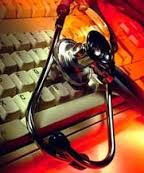 The conversion of paper documents into Electronic Health Records (EHRs) or Electronic Medical Records (EMRs) picked up pace when the Affordable Care Act With EHR, wherever the patient goes, physicians can access the information they need to treat the patient. Though it is really helpful for data collection, many physicians find it a cumbersome task to enter data into the EHR. According to a study conducted by the RAND Corporation, a California research group, electronic conversion is a stress factor contributing to physician professional satisfaction. Doctors often enter data when the patient is sitting in front of them and this result in the patients not receiving the attention they expect. Dr. Daniel Heinemann, president of the South Dakota State Medical Association says that they have got complaints from patients about less eye contact during office visits as doctors turned away while typing on their keyboard. It seems that the relevance of medical transcription is increasing in this context. Let’s see how.
The conversion of paper documents into Electronic Health Records (EHRs) or Electronic Medical Records (EMRs) picked up pace when the Affordable Care Act With EHR, wherever the patient goes, physicians can access the information they need to treat the patient. Though it is really helpful for data collection, many physicians find it a cumbersome task to enter data into the EHR. According to a study conducted by the RAND Corporation, a California research group, electronic conversion is a stress factor contributing to physician professional satisfaction. Doctors often enter data when the patient is sitting in front of them and this result in the patients not receiving the attention they expect. Dr. Daniel Heinemann, president of the South Dakota State Medical Association says that they have got complaints from patients about less eye contact during office visits as doctors turned away while typing on their keyboard. It seems that the relevance of medical transcription is increasing in this context. Let’s see how.
Difficulties Caused by EHR
- Though it is possible to access patient healthcare information wherever they go using the EHR system implemented in each healthcare system they visit, none of the systems communicate with each other and this is really trying for doctors. There is also the problem of lack of portability when a patient with a doctor in one system requires help from another.
- As per the South Dakota State Medical Association, the electronic systems hinder face-to-face conversation and doctors would need to spend more time for clerical work if they want to avoid this. Moreover, the accuracy of medical records is reduced due to template-generated notes. The entire clinical narrative cannot be captured using checkboxes or templates alone and the doctors lose a lot of time by clicking boxes. Since there is no third party to check the content (as the doctors themselves edit the observations), there is no scope for quality checks.
- As it is time-consuming for doctors to fill out templates, the number of patients seen in a day gets reduced. If the physician tries to fit in more patients in his schedule, it will reduce the time spent with each patient which in turn will reduce the quality of care. It is estimated that if doctors who struggle with electronic records can see around 10 patients a day then others can see around 40 patients on the same day. Some experts say that most physicians who have implemented EHR system saw a drop of 10 to 20 percent in patient volume in the first month or two. If you have a clinic that is not efficient and set out to implement an EHR system, it may prove to be an unwise move. The clinic is already in bad condition; you end up spending a lot of money and may not be able to increase productivity quickly with HER.
Some experts recommend advanced dictation and speech recognition systems to solve these issues while some others recommend implementing new design for patient exam room so that it would place the doctor, patient and computer screen in a triangle and the doctor could see both the screen and the patient and type without losing eye contact.
How Medical Transcription and EHR Is a Better Combination
Combining EHR and transcription is better as it will improve the quality and ensure Medicare and Medicaid incentives. In this system, the physician dictates via phone or handheld devices, the digital voice files are securely captured, encrypted and stored on servers by the medical transcription company, clinical documents are transcribed from the recordings, quality checking is performed, documentation is integrated directly to the EHR so that it will available to clinician and HIM staff.
Dictation is a faster and easier clinical documentation option and if digital recorders are used, it will generate quality digital recordings which are easier for transcriptionists to transcribe. Moreover, this will shift the responsibility of clinical documentation from physicians to documentation specialists. In this way, physicians can reduce the time spent for entering data into EHR, see more patients in a day, and extend the time with patients so that it will improve productivity and quality care.
Medical transcription supports narrative-based open-ended dialogue rather than stumble upon restrictive questions with electronic templates. Clinical narrative is the first person view of a patient visit and is important when it comes to making a correct diagnosis and determining best treatment. Transcription provides a smooth and significant option enabling the capture of full patient story including medical history, allergies, current medical status and other relevant details.
In essence, the use of dictation and transcription with an EHR can ensure time efficiency, better quality care, enhanced security (as the documents are encrypted) and help generate more comprehensive medical records so that the probability of negative medical effects can be reduced a lot.


